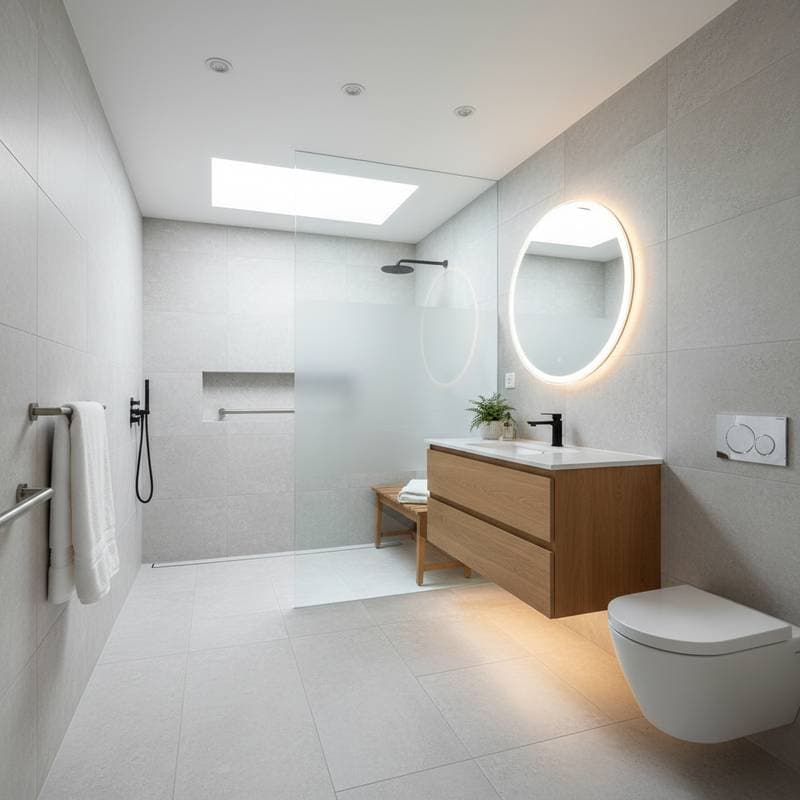Why Wet Rooms Outperform Traditional Showers in Luxury Homes
As a contractor with extensive experience in bathroom renovations, I observe that wet rooms represent a hallmark of contemporary luxury residences. These installations extend beyond mere aesthetics to influence functionality, ambiance, and longevity. While many homeowners select wet rooms for their visual appeal, the advantages encompass practical performance and enduring reliability.
A wet room constitutes a comprehensively waterproofed bathroom space where the shower integrates without enclosure or base. The entire area withstands direct water contact. Correct implementation features a gentle floor gradient guiding water to a hidden drain, with all surfaces protected by impermeable layers. This creates an expansive, pristine, and sophisticated environment.
The following sections examine the reasons wet rooms prevail in premium properties, the elements that ensure their success, and essential considerations for homeowners.
Seamless Design and Spatial Expansion
Wet rooms excel in design versatility and spatial efficiency, distinguishing them from enclosed traditional showers. Conventional setups impose boundaries with doors, screens, or curbs that fragment the room and limit visual flow. In contrast, wet rooms eliminate such barriers, fostering an airy, unified composition that amplifies perceived size.
Homeowners gain freedom to incorporate expansive materials like large porcelain slabs or polished stone across floors and walls, creating continuity. This approach suits minimalist or opulent styles equally, allowing integration of features such as radiant floor heating or ambient lighting without compromise. The result enhances the bathroom's role as a serene retreat, maximizing every square foot for both utility and elegance.
Durability Through Comprehensive Waterproofing
Luxury elements endure when engineered for resilience, and wet rooms embody this principle. Traditional showers depend on targeted sealing; a fractured grout joint or displaced base permits water infiltration, leading to substructure decay. I have dismantled numerous such systems where concealed moisture inflicted substantial harm.
Wet rooms adopt a holistic strategy. Before applying tiles or finishes, the full floor and lower walls receive a unified membrane, often paired with cement boards and elastic sealants. This forms an impervious enclosure. Should a tile sustain damage, the underlying shield prevents subfloor exposure.
Such protection preserves surface integrity over years. Premium finishes like natural stone or textured plaster resist degradation from hidden dampness. Consequently, maintenance demands decrease, and the bathroom maintains its pristine state longer.
Enhanced Accessibility and Universal Appeal
Wet rooms promote inclusivity, a key consideration in modern luxury design. Traditional showers often feature thresholds or tight enclosures that challenge mobility, particularly for aging residents or those with disabilities. The barrier-free nature of wet rooms facilitates easy entry, supporting lifelong usability.
This design aligns with universal principles, accommodating grab bars, adjustable heads, or bench seating seamlessly. Families appreciate the adaptability for varying needs, from daily routines to therapeutic soaks. In high-end homes, this foresight contributes to a thoughtful, future-proof environment that resonates with diverse buyers.
Simplified Maintenance and Superior Hygiene
Traditional showers conceal issues until they escalate. Seals degrade unnoticed, allowing moisture to accumulate behind components. Wet rooms offer transparency; all areas remain accessible for inspection. With minimal seams, cleaning proves efficient and thorough.
Select durable options like oversized porcelain tiles or stone paired with epoxy grout to repel stains and mildew. These surfaces retain smoothness through regular use. The waterproof integrity permits liberal rinsing of walls and floors, free from splash concerns.
Effective ventilation remains vital. Install an inline fan with humidity detection to expel moisture swiftly post-shower. Combined with periodic surface wiping, these practices keep the space hygienic and inviting, outperforming enclosed alternatives.
Boosted Property Value and Buyer Attraction
In the luxury sector, bathrooms command significant scrutiny from prospective buyers. A well-crafted wet room conveys superior quality, meticulous execution, and forward-thinking design. Agents frequently highlight them as spa-inspired havens, drawing immediate interest.
For resale, wet rooms modernize properties, even historic ones, by demonstrating intentional updates. Elements like bespoke mosaics, underfloor warmth, and premium hardware elevate the allure. Renovated bathrooms with wet rooms photograph compellingly, their open expanses and luminous finishes captivating online viewers.
Homeowners investing for longevity find that wet rooms enhance market positioning. The combination of comfort and contemporary appeal accelerates sales and supports premium pricing in competitive landscapes.
Essential Construction Principles and Avoidable Errors
Wet rooms demand meticulous planning and expert execution to realize their potential. A frequent oversight involves inadequate slope or drainage, resulting in pooled water that causes discoloration or hazards.
Homeowners must verify these core aspects prior to project approval:
-
Subfloor Reinforcement
Ensure the base supports membrane and tile loads without deflection, preventing future fractures. -
Precise Gradient
Achieve a minimum quarter-inch drop per foot to the drain for efficient runoff. -
Unified Sealing
Apply compatible materials across joints, angles, and fixtures to eliminate vulnerability points. -
Robust Ventilation
Equip with a silent, high-capacity fan to manage post-use humidity. -
Experienced Craftsmanship
Confirm the team's proficiency in comprehensive waterproofing techniques.
Neglecting these fundamentals undermines the installation. Success hinges on precision from structural base to final detailing.
Balancing Costs with Enduring Returns
Initial expenses for wet rooms surpass those of traditional showers, typically ranging from 20 to 50 percent higher due to specialized materials and labor. Factors include room size, finish selections, and site complexities like existing plumbing adjustments.
However, the investment yields substantial returns. Reduced repair frequency offsets upfront costs within a decade. Enhanced energy efficiency from integrated heating and ventilation further contributes to savings. For long-term owners, the blend of durability and aesthetic uplift justifies the premium.
Realizing the Full Potential of Your Wet Room
A thoughtfully installed wet room elevates daily rituals into indulgent experiences. Its open design invites personalization, from subtle lighting to aromatic diffusers, fostering a private sanctuary. Homeowners report heightened satisfaction with the fluid movement and effortless care.
To sustain this excellence, schedule annual inspections for seals and drainage. Experiment with complementary accessories that harmonize with the architecture. Ultimately, a wet room not only outlasts but enriches the heart of luxury living.










